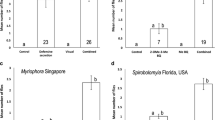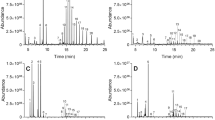Abstract
Several pharmacophagous insects have been shown to sequester specific kairomonal substances or their derivatives in their body tissues. Turnip sawflies,Athalia rosae, visit a plant,Clerodendron trichototmum (Verbenaceae), and feed voraciously on the leaf surface. Clerodendrins were characterized as the potent phagostimulants forA. rosae adults. The insect sequesters some of the analogs and becomes extremely bitter on its body surface. Some chrysomelid leaf beetles associated with cucurbitacins were found to store high concentrations of these bitter principles in their body. South American polyphagous beetles,Diabrotica speciosa andCerotoma arcuata, are strongly arrested by root components from the cucurbit plant,Ceratosanthes hilariana, and selectively accumulate 23,24-dihydrocucurbitacin D, effectively gaining bitterness. Similarly, four species of Asian pumpkin leaf beetles belonging to the genusAulacophora were shown to sequester the same compound in body tissue as the major bitter principle. Three phenylpropanoids closely related to methyl eugenol were found to accumulate in the rectal glands of the male Oriental fruit fly,Dacus dorsalis. One of the rectal gland components, 2-allyl-4,5-dimethoxyphenol was shown to be released in the air during courtship. In all of these cases, selectively sequestered compounds strongly deterred feeding by some predators, thus serving as allomones in this context. Kairomonal and pheromonal functions linked with allomonal sequestration by pharmacophagous feeding has also been suggested.
Similar content being viewed by others
References
Abe, M. 1988. A biosystematic study of the genusAthalia Leach of Japan (Hymenoptera: Tenthredinidae).Esakia 26:91–131.
Belles, X., Camps, F., Coll, J., andPiulachs, M.D. 1985. Insect antifeedant activity of clerodane diterpenoids against larvae ofSpodoptera littoralis (Boisd) (Lepidoptera).J. Chem. Ecol. 11:1439–1445.
Blaney, W.M., Simmonds, M.S.J., Ley, S.V., andJones, P.S. 1988. Insect antifeedants: A behavioral and electrophysiological investigation of natural and synthetically derived clerodane diterpenoids.Entomol. Exp. Appl. 46:267–274.
Blum, M.S. 1981. Chemical Defenses of Arthropods. Academic Press, New York.
Boppré, M. 1978. Chemical communication, plant relationships, and mimicry in the evolution of danaid butterflies.Entomol, Exp. Appl. 24:64–77.
Boppré, M. 1984. Redefining “pharmacophagy. ”J. Chem. Ecol. 10:1151–1154.
Boppré, M. 1986. Insects pharmacophagously utilizing defensive plant chemicals (Pyrrolizidine alkaloids).Naturwissenschaften 73:17–26.
Boppré, M., Petty, R.L., Schneider, D., andMeinwald, J. 1978. Behaviorally meadiated contacts between scent organs: Another prerequisite for pheromone production inDanaus chrysippus males (Lepidoptera).J. Comp. Physiol. 126:97–103.
Brower, L.P. 1969. Ecological chemistry.Sci. Am. 220:22–29.
Chambers, D.L. 1977. Attractants for fruit fly survey and control, pp. 327–344, in H.H. Shorey and J.J. Mckelvey (eds.). Chemical Control of Insect Behavior. Wiley, New York.
Chambliss, O.L., andJones, C.M. 1966a. Cucurbitacins: Specific insect attractants in cucurbitaceae.Science 153:1392–1393.
Chambliss, O.L., andJones, C.M. 1966b. Chemical and genetic basis for insect resistance in cucurbits.Proc. Am. Soc. Hortic. Sci. 89:394–405.
Conner, W.E., Eisner, T., Vander Meer, R.K., Guerrero, A., andMeinwald, J. 1981. Precopulatory sexual interaction in an arctiid moth (Utetheisa ornatrix): Role of a pheromone derived from dietary alkaloids.Behav. Ecol. Sociobiol. 9:227–235.
DaCosta, C.P., andJones, C.M. 1971. Cucumber beetle resistance and mite susceptability controlled by the bitter gene inCucumis saliva L.Science 172:1145–1146.
David, A., andVallance, D.K. 1955. Bitter principles of Cucurbitaceae.J. Pharm. Pharmacol. 7:295–296.
Doskotch, R.W., andHufford, C.D. 1970. Hexanor-cucurbitacin D, a degraded cucurbitacin fromBegonia tuberhybrida var.alba. Can. J. Chem. 48:1787–1788.
Duncan, G.R., Levi, D.D., andPyttel, R. 1968. Bitter principles of the cucurbitaceae:Bryonia dioica.Planta Med. 16:224–229.
Ferguson, J.E., andMetcalf, R.L. 1985. Cucurbitacins: Plant derived defense compounds for diabroticites (Coleoptera: Chrysomelidae).J. Chem. Ecol. 11:311–318.
Ferguson, J.E., Metcalf, R.L., andFisher, D.C. 1985. Disposition and fate of cucurbitacin B in five species of diabroticites.J. Chem. Ecol. 11:1307–1321.
Fletcher, B.S., Bateman M.A., Hart, N.K., andLamberton J.A. 1975. Identification of a fruit fly attractant in Australian plant,Zieria smithii, asO-methyl eugenol.J. Econ. Entomol. 68:815–816.
Geuskens, R.B.M., Luteijin, J.M., andSchoonhoven, L.M. 1983. Antifeedant activity of some ajugarin derivatives in three lepidopterous species.Experientia 39:403–404.
Gould, F., andMassay, A. 1984. cucurbitacins and predation of the spotted cucumber beetle,Diabrotica undecimpunctata howardi.Entomol. Exp. Appl. 36:273–278.
Hernández, A., Pascual, C., Sanz, J., andRodríguez, B. 1982. Diterpenoids fropmAjuga chamaepitys: Two Neo-clerodane derivatives.Phytochemistry 21:2909–2911.
Kato, N., Shibayama, S., andMunakata, K. 1971. Structure of the diterpene clerodendrin A.J. Chem. Soc. Chem. Commun. 1971:1632–1633.
Kato, N., Takahashi, M., Shibayama, S., andMunakata, K. 1972. Antifeeding active substances for insects inClerodendron trichotomum Thumb. Agric. Biol. Chem. 36:2579–2582.
Kawano, Y., Mitchell, W.C., andMatsumoto, H. 1968. Identification of male Oriental fruit fly attractant in the golden shower blossom.J. Econ. Entomol. 61:986–988.
Kitano, H. 1988. Experimental studies on the mating behavior ofAthalia lugens infumata.Kontyu 56:180–188.
Kobayashi, R.M., Ohinata, K., Chambers, D.L., andFujimoto, M.S. 1978. Sex pheromones of the Oriental fruit fly and the melon fly: Mating behavior, bioassay method, and attraction of females by live males and by suspected pheromone glands of males.Environ. Entomol. 7:107–112.
Kubo, Lee, Y.W., Bologh-Noir, V., Nakanishi, K., andChapya, A. 1976. Structure of ajugarins.J. Chem. Soc. Chem. Commun. 1976:949–950.
Lavie, D., andGlotter, E. 1971. The cucurbitacins, a group of tetracyclic triterpens.Fortschr. Chem. Org. Naturst. 29:307–362.
Meinwald, J., Meinwald, Y.C., andMazzocchi, P.H. 1969. Sex pheromone of Queen butterfly: Chemistry.Science 164:1174–1175.
Metcalf, R.L. 1979. Plants, chemicals, and insects: Some aspects of coevolution.Bull. Entomol. Soc. Am. 25:30–35.
Metcalf, R.L. 1986. Coevolutionary adaptations of rootworm beetles (Coleoptera. Chrysomelidae) to cucurbitacins.J. Chem. Ecol. 12:1109–1124.
Metcalf, R.L., Rhodes, A.M., Metcalf, R.A., Ferguson, J., Metcalf, E.R., andLu, P.Y. 1982. Cucurbitacin contents and diabroticite (Coleoptera: Chrysomelidae) feeding uponCucurbita spp.Environ. Entomol. 11:931–937.
Nielson, J.K., Larsen, M., andSorenson, H.J. 1977. Cucurbitacins E and I inIbelis amara, feeding inhibitor forPhyllotreta nemorum.Phytochemistry 16:1519–1522.
Nishida, R., Fukami, H., Baker, T.C., Roelofs, W.L., andAgree, T.E. 1985. Oriental fruit moth pheromone: Attraction of females by an herbal essence, pp 47–63,in T.E. Acree, and D.M. Soderlund (eds.). Semiochemistry: Flavor and Pheromones. Walter de Gruyter, Berlin.
Nishida, R., Fukami, H., Tanaka, Y., Magalhāes, B.P., Yokoyama, M., andBlumenschein, A. 1986. Isolation of feeding stimulants of Brazilian leaf beetles (Dibrotica speciosa andCerotoma arcuata) from the root ofCeratosanthes hilariana.Agric. Biol. Chem. 50:2831–2836.
Nishida, R., Tan, K.H., Serit, M., Lajis, N.H., Sukari, A.M., Takahashi, S., andFukami, H. 1988a. Accumulation of phenylpropanoids in the rectal glands of males of the Oriental fruit fly,Dacus dorsalis.Experientia 44:534–536.
Nishida, R., Tan, K.H., andFukami, H. 1988b.Cis-3,4-Dimethoxycinnamyl alcohol from the rectal glands of male Oriental fruit fly,Dacus dorsalis.Chem. Express 3:207–210.
Nishida, R.,Yokoyama, M., andFukami, H. 1990. Sequestration of cucurbitacins by the New and Old World chrysomelid beetles. In preparation.
Nishida, R., Fukami, H., Miyata, T., andTakeda, M. 1989. Clerodendrins: Feeding stimulants of the adult turnip sawfly,Athalia rosae ruficornis, fromClerodendron trhciotomum (Verbenaceae).Agric. Biol. Chem. 53:1641–1645.
Ohinata, K., Jacobson, M., Kobayashi, R.M., Chambers, D.L., Fujimoto, M.S., andHiga, H.H. 1982. Oriental fruit fly and melon fly: Biological and chemical studies of smoke production by males.J. Environ. Sci. Health A17:197–216.
Schneider, D., Boppré, M., Zweig, J., Horsley, S.B., Bell, T.W., Meinwald, J., Hansen, K., andDiehl, E.W. 1982. Scent organ development inCreatonotos moth: Regulation by pyrrolizidin alkaloids.Science 215:1264–1265.
Shah, A.H., andPatel, R.C. 1975. Role of Tulsi plant (Ocimum sanctum) in control of mango fruit fly,Dacus correctes Bezzi (Tephritidae: Diptera).Curr. Sci. 45:313–314.
Sillén-Tullberg, B. 1988. Evolution of gregariousness in aposematic butterfly larvae: A phylogenetic analysis.Evolution 42:293–305.
Sinha, A.K., andKrishna, S.S. 1969. Feeding ofAulacophora foveicollis on cucurbitacin.J. Econ. Entomol. 62:512–513.
Sinha, A.K., andKrishna, S.S. 1970. Further studies on the feeding behavior ofAulacophora foveicollis on cucurbitacin.J. Econ. Entomol. 63:333–334.
Steiner, L.F., Mitchell, W.C., Harris, E.J., Kozuma, T.T., andFujimoto, M.S. 1965. Oriental fruit fly eradication by male annihilation.J. Econ. Entomol. 58:961–964.
Author information
Authors and Affiliations
Rights and permissions
About this article
Cite this article
Nishida, R., Fukami, H. Sequestration of distasteful compounds by some pharmacophagous insects. J Chem Ecol 16, 151–164 (1990). https://doi.org/10.1007/BF01021276
Received:
Accepted:
Issue Date:
DOI: https://doi.org/10.1007/BF01021276




